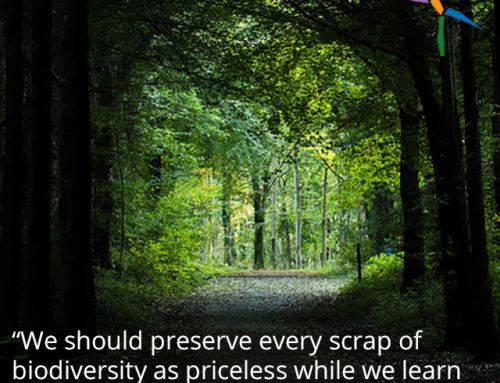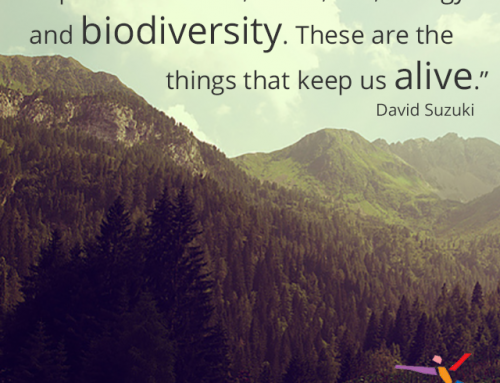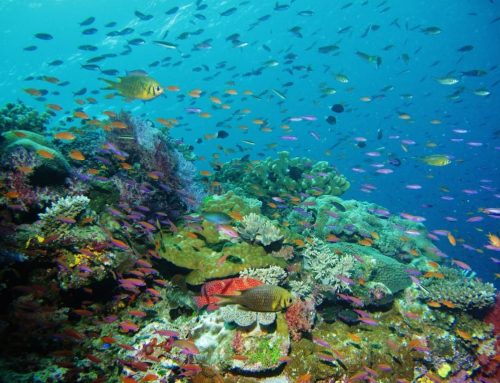So what are you doing with your summer? For most people, summer means a time of increased free time, vacations, and even some relaxation. We understand that, for some, that’s certainly not true. But for anybody who is involved in most education calendars or has kids in school, who works a job with a slower summer season or who regularly takes their vacation time in the summer, things are slightly less stressful and busy once the sun is consistently out. And if you’re a person with a slower summer, then that means you have options to explore for what you want to do with your summer. From finding eco-friendly ways to relax to taking on a project or two, we have plenty of ideas on how you can put something on your summer to-do list that will help save the planet. For our featured May content, we’ve compiled them all together to help you get ready for a splendid sunny summer!
The Leisure Projects: You Can Relax and Also Do Good for the Environment!
Believe it or not, every project that you undertake to help save the planet doesn’t have to be “work.” You can do relaxing or invigorating summer activities that also are progressing towards a goal of making the Earth a safer, cleaner and better place to be. Here are five ideas for slowing down, relaxing and de-stressing this summer that also help the planet we call home.
1. Your Summer Reading List: Get Inspired About the Earth
Even in this era of digital media, most people still embrace the summer reading list. The temptation, at least for us, is to fill this reading list up with “fluff” or “light” summer reads. Yes, there’s a contingent of the Postconsumers content team who have read the Twilight books … and the Hunger Games books … and a whole series of mystery novels of questionable quality. But you can actually get just as much enjoyment and relaxation from books that are more classic and also that will get you inspired about protecting the environment. We recommend the writings of Rachel Carson, David Suzuki and John Muir to get you started. But if you do a simple search at the bookseller (online or brick-and-mortar) of your choice, you’ll find an entire range of compelling fiction, non-fiction and poetry books that will inspire you to make great choices about saving this beautiful planet of ours. And we won’t judge you if you mix those books in with some romance novels of questionable quality – because we’ll likely be doing the same thing!
2. Take a Vacation to an Eco-Travel Destination
We start this paragraph by immediately conceding that there is an ongoing debate about whether eco-travel is really eco-friendly. We’ve taken the stand that the value of travelling and seeing the world and educating yourself trumps the carbon footprint, but that you should obviously make wise decisions about minimizing your travel carbon footprint when you head out for your vacation. All of that said, what we’re boiling it down to here is that any trip to an eco-travel destination helps the planet in two ways. Firstly, it gets you inspired, teaches any children that you bring with you to love the earth and gets you closer to nature if that’s not part of your day-to-day life. The second reason it helps the planet is equally important. At the end of the day, we all vote more with our dollar than we do with our ballots. When you spend your money specifically at a destination that makes eco-friendly choices then you pressure other destinations to do the same. Take a vacation! Enjoy it! Support eco-travel options.
3. Spend Time in Public or National Parks
It’s no secret that anything that is funded by government money is increasingly on the chopping block in terms of getting resources allocated to it. That’s certainly true for green spaces like local public parks as well as larger national parks. Much like you can vote with your dollar when you choose a larger vacation destination, you can vote with your dollar – or simply your presence – by making sure that you utilize the green spaces available to you. What are you doing this afternoon on a lazy summer day? Pack a snack, grab a blanket and go lay in the sun (with sunscreen of course) in the park. Have weekend plans? Take a weekend trip to the lodge, cabins or even camping facilities at a State or National park. When you utilize the green spaces in your area and show that they are a priority – then you also put pressure on the powers that be to keep them funded.
4. Grow Some Beautiful Flowers or Plant a Tree
We’re going to talk about gardening on a larger scale later in this piece, but if full-on gardening isn’t your thing there are smaller ways to spend a leisurely day relaxing in the sun with some dirt and some plants and doing the planet a favor at the same time. The more that you contribute organic green matter to the planet, the better it is. So spend that day relaxing and potting plants on your porch or patio – or make this the summer that you really do plant a small tree in your yard (if you have one). Yes, there’s an element to this that is more work than leisure, but we think that you’ll find the relaxing element is greater than the physical labor element. We also think that you’ll find your stress level reduced just by the exposure to the beauty of plants.
5. Go Hiking! Lots of Hiking!
We’re big believers that healthier bodies are also healthier for the planet. There are plenty of reasons for this belief, but we’re saving those for an entirely different blog entry! What we can say here is the more times you can improve your body while also supporting local green spaces, the better. So get out there and go hiking. Even if it’s just a short hike to start the process of getting yourself in shape, it’s better than staying inside during the best weather of the year in many places. Hike. It’s good for your body – and it benefits the planet.
The Food Projects: Growing Season is Good for the Planet
Not everybody is a green thumb. We get that! But from small projects like simply changing your shopping habits to take advantage of summer growing season to bigger undertakings like your very first (small) garden, summer provides a lot of opportunities to enjoy the benefits of getting dirt on you and aid the planet by helping to make its food supply more eco-friendly. Try these six summer projects to help minimize the carbon footprint of food, glorious food.
6. Embrace Summer Farmer’s Markets
There are plenty of mental health benefits to going to a farmer’s market that extend beyond the type, quality and purity of food that you’ll find there. However, it’s the food that you’re purchasing that will create the impact on the planet that you want – and there’s no better time to begin the habit of regular trips to a farmer’s market like the summer. The produce is at its natural harvest peak and the weather is delightful for just about anything that you do outside. How are you helping to save the planet by going to a farmer’s market? There may be too many to list, but we’ll give you a few of our favorites. You’re reducing the food miles associated with the food that you eat, which is in many cases the biggest carbon footprint of food. You’re also eating (in most cases – be sure to ask) organic food that’s grown without chemicals and pesticides that harm the planet. And, finally, you’re educating yourself and anybody who joins you about natural food.
7. Grow Your Own Food at Home. Learn the Love of Gardening for Yourself.
We know that this would qualify as a big undertaking for anybody who hasn’t been regularly gardening for most of their life, but trust us when we say that it will be worth it not only for the sake of the earth but also for your personal mental health and wellbeing. Everything that we just said that you would be doing to benefit the planet by shopping at a local farmer’s market gets exponentially increased when you grow your own food. In fact, so much so that the next two projects we’re listing are other variations on gardening! You’ll almost entirely eliminate the food miles associated with anything that you grow to eat (we assume some carbon miles to buy seeds, soil and supplies). You’ll be adding green space to the planet. You can choose to garden organically. And, of course, you’ll be reducing carbon footprint from the packaging that your store-bought food comes in. Yes, starting a garden is a big project. But the rewards, both edible and otherwise, are as well.
8. Join a Community Garden to Double the Benefits.
Any time that you can do a project that doesn’t just benefit you but also benefits an entire community, it’s even better for the planet and the people on it. We’ve talked before about the many reasons to love your local community garden, but in reference to aiding the world we’ll run through the big ones quickly. Not only are you helping to create more green spaces, you’re helping to create what is likely to be a very large green space in a place where there aren’t all that many green spaces. Then add on all of the gardening advantages to reducing food miles, reducing chemicals and reducing packaging and multiply them out. However, we think that the biggest way that you’re helping the planet when you participate in a community garden is by bringing people together. It will take a unified effort of people who believe and feel invested in each other to truly change the way our world is operating. Coming together to grow food is a great way to start that process, and you can be a part of it.
9. Learn to Garden Indoors for the Urban Living Revolution
Both of the gardening projects we’ve listed above require you to have space, either private or shared, to garden in. But America (and many other parts of the world) is undergoing a significant demographic shift to more people living in urban environments where gardening and farming spaces just aren’t that easy to come by. But that doesn’t mean you can’t still choose to grow a significant portion of your own food and herbs (the food flavor kind, not the other kind). As passionate environmentalists and fresh food lovers have shifted to urban environments, they’ve crafted many solutions to gardening indoors or in an urban living situation. If you live in an urban setting, take some time this summer to try just one trick for growing things that you can eat in your apartment or city-house setting.
10. Learn to Pickle and Preserve. It Will Also Come In Handy for the Zombie Apocalypse.
We’ve mentioned the eco-benefits of pickling and preserving your food before, but it’s worth repeating. Most western countries have developed terrible expectations of being able to eat fresh produce year-round regardless of its seasonality. However, that comes with a big impact to the planet. All of that food (or at least the majority of it that isn’t greenhouse grown, which has its own issues with sustainability) has to be grown somewhere where the actual weather season supports it. Then it has to be flown (or in some cases shipped) to where you are for you to purchase and eat it. We’re not just talking food miles, we’re talking epic food miles, and food miles in energy sucking temperature-controlled climates. Not to mention the huge amount of food packaging needed for this type of transcontinental food movement. Make a shift towards eating seasonally appropriate food, which is better for the planet, but getting “homey” and learning how to pickle and preserve what is fresh in the summer for use in the winter.
11. Reduce the Meat In Your Diet. Consider Trying Meatless Monday!
The single biggest carbon footprint related to food, globally, is in the production of meat. Meat not only requires all of the same carbon footprint elements we talked about above – packaging, food miles, energy – but it also requires that the animals who later become the meat are fed. That necessitates devastation of lands for grazing, huge amounts of water both for the animals’ drinking water and to create the crops that feed the animals that become the meat, and massive amounts of packaging and energy to convert crops to animal feed. It’s a huge carbon footprint that’s only somewhat reduced when you focus on purchasing locally. The less meat you eat, the better it is for the planet. So tackle a summer project of actively reducing the amount of meat in your diet. It can be as simple as adopting Meatless Monday, which only asks you to go one day without meat products, or as complex as learning how to maintain an entirely vegan diet. The option is entirely yours, but either way the planet will thank you.
The Water Projects: Summer is Water Conservation Season
While water conservation is a priority all year long, it becomes an even more critical priority in the summer months when we all tend to use more water to combat dryness or to create the “optimal” green environment around us. That’s why we made sure to include a section on projects that you can do this summer that will specifically help combat the peak water epidemic that’s working its way across the globe. As one proverb says, you can’t clean filthy water. But you can do things that will assist you to help the planet preserve the water that it has. Here are just a few water related projects you can dive into (pun intended).
12. Change Your Restaurant Behavior
If you’re anything like us, you tend to dine out more in the summer. More free time and the reduced financial stress of not having to deal with the pressure of consumer season means more eating good food with friends in public places. One small habit-changing project can make a big impact on the world’s water supply, especially if you gently encourage your friends to adopt this habit, too. Stop taking the complimentary glass of water at a restaurant unless you truly plan to drink the entire thing. For each glass of water that you drink at a restaurant, it actually generates water use equivalent to three glasses of water by the time the glass is done being washed and sanitized. So if you’re only planning to sip on that glass of water until your “real” drink arrives, then just say “no thank you” before the server brings the water out so that you can help reduce overall water waste.
13. Go Big and Landscape Your Yard
You’ll need to go big for this project in a couple of ways. Firstly, you’ll need to let go of a belief that the only good yard is a yard full of lush grass and vibrant flowers. That may be somewhat true if you live in the deep south or the Midwest – or even parts of the east coast. But once you cross over the Mississippi River, that type of vegetation isn’t native any more, and the only way to obtain it is by using enormous amounts of water to supplement what nature is already providing. It’s time to re-landscape your yard using the greenery – or sand, rocks or other beautiful gifts of the planet – that nature provided. Not only will you reduce an excessive amount of water use, but you may just find that your yard looks even better when it’s designed like nature intended. Of course, this project doesn’t just apply to people with desert or shrub-based natural landscapes. If you’re in a grass and flower climate but using huge amounts of daily water to keep your grass “golf course” perfect, then we’d certainly encourage you to undertake a landscaping project that will reduce that requirement.
14. Dry Out. Drink Less Booze … for the Planet.
Summer – for many it’s the time of beers and margaritas. We admit that we also like our summer adult beverages, but are you aware of how much water is required to create our adored booze? Beer, in particular, is a high-water production beverage. Beer isn’t alone, and most alcohols require a significant amount of water in the brewing and/or distilling process. You may not have noticed this yet, but prices on liquor and booze have been climbing as access to or the cost of industrial water use rises. Take a moment, think about how much you drink during the summer and then think about how much healthier your body would be with slightly less booze in it. Then consider how much happier the planet will be with less pressure on its water reserves. We’re not saying that sober summer has to be the name of your game this year. We’re just saying a little less booze and a little less bottled water is good for you, good for the planet and a great project to undertake.
15. Be Your Own Handyman and Install Low Flow Solutions in Your Bathroom
Maybe you don’t love home DIY projects, but this one can certainly help reduce your drain on the water supply. Install low-flow controllers in your toilets and shower. Yes, we know, you love your hot water pressure in the shower. But do you love a world where water isn’t affordable to people and you only get to shower once a week? Yes, we know that sounds extreme, but it’s a real possibility if we don’t get our over-use of the world’s most important resource under control. Plus, once you do one home DIY project, you may find that you really love it. Then think about what a wide world of fun and opportunity is open to you!
For Kids: Summer Environmental Projects for Children and Teens
We’ve spent a lot of page space in the last year on the topic of parenting tips to raise postconsumer kids. That’s because we feel passionately about the topic. While there’s some evidence that the millennial generation is moving away from addictive consumerism as a natural ebb and flow of society, the real future is always about the priorities we consciously instill in our children. And as any parent knows, in large part that means finding ways to make topics fun for children so that they have a positive association with them moving forward. We kept that in mind as our team brainstormed these summer projects for kids that can help make them responsible planet advocates moving forward.
16. Camp in the Backyard (if You Have One)
We know that with the shift to more urban living, not everybody has the luxury of a backyard. However, if you do it’s a great way to get kids excited about nature and the planet without having to embark on a travel-rich, full-on weekend camping trip. Set up a tent and let your kids live outdoors for the weekend. Cook over a fire, let them sleep under the stars and make things extra fun with structured play and games about the outdoors. Even in your own backyard you can often identify different types of foliage and animals. If possible, try to really make the weekend (or just one night) about nature and avoid the temptation of smartphones, tablets or outdoor movies. The idea is to embrace nature close by in a way that will make your children want to save the planet. How you structure the weekend or night will depend greatly on what’s accessible in your backyard, but even just getting your kids into the outdoors for the evening will make a gigantic difference down the road.
17. Make a Wind Turbine and Learn About Alternative Energy
Here’s a tip: if you Google “environmental projects for kids,” most of your search result feed will be about projects that involve making a wind turbine. We actually originally didn’t have this one in our list, but after we saw how common it was we felt like it would be remiss to not include it. No matter how you feel about alternative clean energy versus fossil fuel energy, one thing is clear: you child will absolutely grow up in a world where alternative energy is a big part of the mix. The more that they understand about it and embrace it the better. And if you’re passionate about clean energy then there’s nothing better than a project in childhood to educate and create enthusiasm for alternative energy in your child. You also may be surprised how easy it is to make a wind turbine. We found this handy YouTube video, but there are literally dozens of tutorials out on the web. It’s a fun project that also teaches science and leaves your children educated, happy and excited about the potential of wind instead of coal.
18. Upcycled Craft Day Can Be Everyday
A child’s summer should be as full of arts and crafts as you can make it. But it’s even better if you can teach your child to find creative ways to reuse and repurpose items instead of waste them while you’re doing your summer full of crafts. There are so many upcycled crafts that you can do with your child. How organized are you with your child during the summer? Scour your home and calendar out upcycled craft projects that teach them about recyclable and reusable materials and why it’s important that those materials don’t make it into the trash. If you’re not that organized – and let’s be honest, most of us aren’t – then just gather up all of the items in your house that you’re thinking of pitching and hand them over to your children with a bunch of craft supplies and see what they come up with. We’re always pro-imagination running wild.
19. The Modern Lemonade Stand: Raise Money for Global Causes
It used to be that kids had lemonade stands to save up money to buy things that they wanted. That, of course, is before we understood the danger of addictive consumerism. Take a twist on the traditional lemonade stand model and let your kids raise money to donate to an environmental cause of their choice. You can stick with the lemonade model or vary it with baked goods, flowers, hand-made crafts, a yard sale or even just have your kids go door-to-door to collect donations with organizational support. Encourage them to educate others about the environment while they’re doing it. Of course, you don’t have to stick entirely to environmental nonprofits with this project. We’ve found that kids love raising money to donate to causes that help animals, and helping animals is always a good way to manifest the planet as more humane. However you contextualize the project, teaching kids that a great use for money that they earn is to make the earth better in some way rather than filling it with more “stuff” is a super lesson.
20. Join a Summer Science Camp. Do It!
In the end, we will save the planet and its population with science. That means that the more your child understands and is excited about science, the better. We know that there are a lot of kids out there who “hate” science, but we honestly believe it’s just because they haven’t been exposed to it in the right way yet. While your child may cringe at the idea of science camp, we strongly feel that after a non-academic immersion in science they’ll be excited about the possibilities of what they can achieve. There are science camps in almost every area of the country, so do some web searching to find the best one for your child. Science is the real answer to rescuing the planet, so arm your child with the knowledge that he or she needs.
The Big Projects: Save the Planet with Serious Summer Projects
For the most part, we’ve tried to keep the projects in this list to manageable things that you can actually accomplish without having to dedicate a massive outpouring of time and financial resources. But some people love a big summer project, and we applaud those people. We also want to provide you with big, serious summer projects that can help a sustainable human future. That’s what you’ll find in our final five suggestions. Yes, these projects are major undertakings, but they’ll yield great results for the planet (and in some cases your energy bill as well). Here are our five favorite “biggies” for summer environmental projects.
21. Weatherize Your Home – Your Entire Home.
We’ve mentioned weatherizing your home in so many lists and articles that we’ve done, but it truly is one of the best things that you can do if you’re trying to help the earth and your budget’s bottom line. What does weatherizing mean? Well that can depend greatly on what your budget and available resources are. Take windows, for example. The best solution if you have older windows is to replace them with ENERGY STAR rated ones. But we’re guessing that, like us, most households don’t have the immediate financing to make that happen. That means weatherizing your windows is about pumping in insulation if there are any fixture gaps to the outside and installing energy saving curtains that hold heat and cool inside of your home. The same goes for every part of your home. Adding insulation, shoring up gaps to the outside and making sure your refrigerator is in the shade and your lightbulbs and batteries are energy efficient are all important starts. Begin with an audit of your home and then commit to all of the weatherizing and energy-efficient projects that you can.
22. Set Up a Rainwater Collection System (If It’s Legal)
Peak water is certainly a concern, as we’ve noted above in the section dedicated to water conservation projects. One thing that can help us all to be more aware of just how actually finite the water supply truly is involves setting up your own rainwater collection system so that you can manage your own water needs and also become more aware of the overall water waste that you’ve likely been participating in versus how much water actually falls from the sky in clean rain format. The catch is that rainwater collection has varying degrees of legality in certain places. You’ll need to check your local zoning and registration requirements, but a rain collection system is always a great summer project with wonderful benefits down the line.
23. Build a Greenhouse and Grow, Grow, Grow.
There’s also a reason that we dedicated an entire section of this massive list to food projects. Taking control of our food supply and creating it in a sustainable way is absolutely essential to the future of the planet. That without a doubt means some type of localized or even individualized growing. But as a society we’ve become used to fresh produce and foods during all seasons, and giving up that benefit of the current global economy may not be that easy. What’s a giant summer project that solves both the need to grow sustainably and gives you access to year-round produce? Assuming you have the space and access, build yourself a greenhouse. You can control much of your own food supply and also have one of the loveliest places to go and have personal time and sunshine time no matter what the time of year.
24. Create Your Recycling Masterpiece
How comprehensive is your recycling effort? Be honest! This is the summer to create your recycling masterpiece: The system in your home with which you will recycle 90% or more of all the potential recyclables in your home. How are you going to do that? There are many ways and you’ll need to figure out the ones that will work best for you. Perhaps it’s having recycling bins throughout the house rather than just in your kitchen. Maybe it’s by making lists and calendars that help you with the effort. Whatever it’s going to take, make this the summer that you finally create your recycling masterpiece and become as close to waste neutral as you can.
25. Transition to Toxin-Free (Or Toxin-Less)
You may be surprised how many items you have in your home that are full of polluting toxins. Even the simple act of purchasing these products can lead to environmental harm – and disposing of what you don’t use is even worse. Make this the summer that you identify all of the potentially toxic products in your home and start to shift to natural, organic or even homeopathic substitutes.
Is that enough to keep you busy for the summer? Whether you select one item from this list or many, we encourage you to pick a project or two for the summer that can do some good for the world and our effort to save it. After all, it’s the only one that we have and there’s still plenty of leisure time in the summer even with a project or two thrown in!
Did we miss an idea for a summer project that could help save the planet? Tell us about it on the social media channels below.
Facebook | Twitter | Instagram | Tumblr | Pinterest | Google+ | Medium
Photo Credit: Will Montague via Flickr





